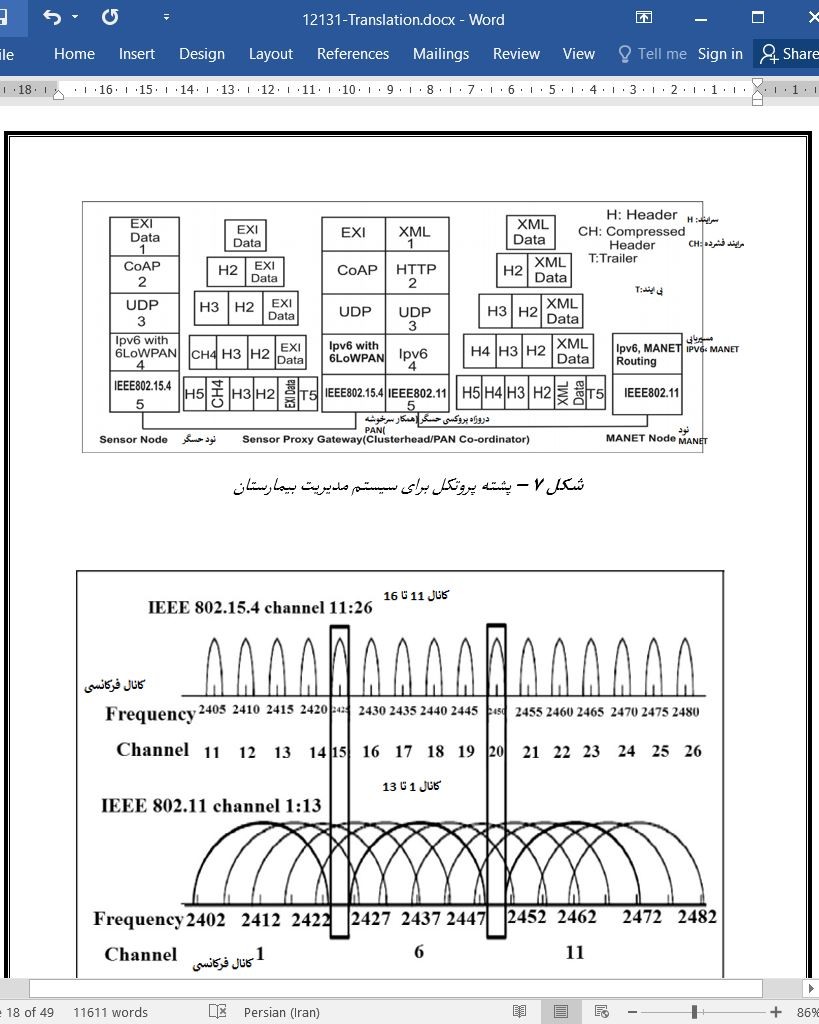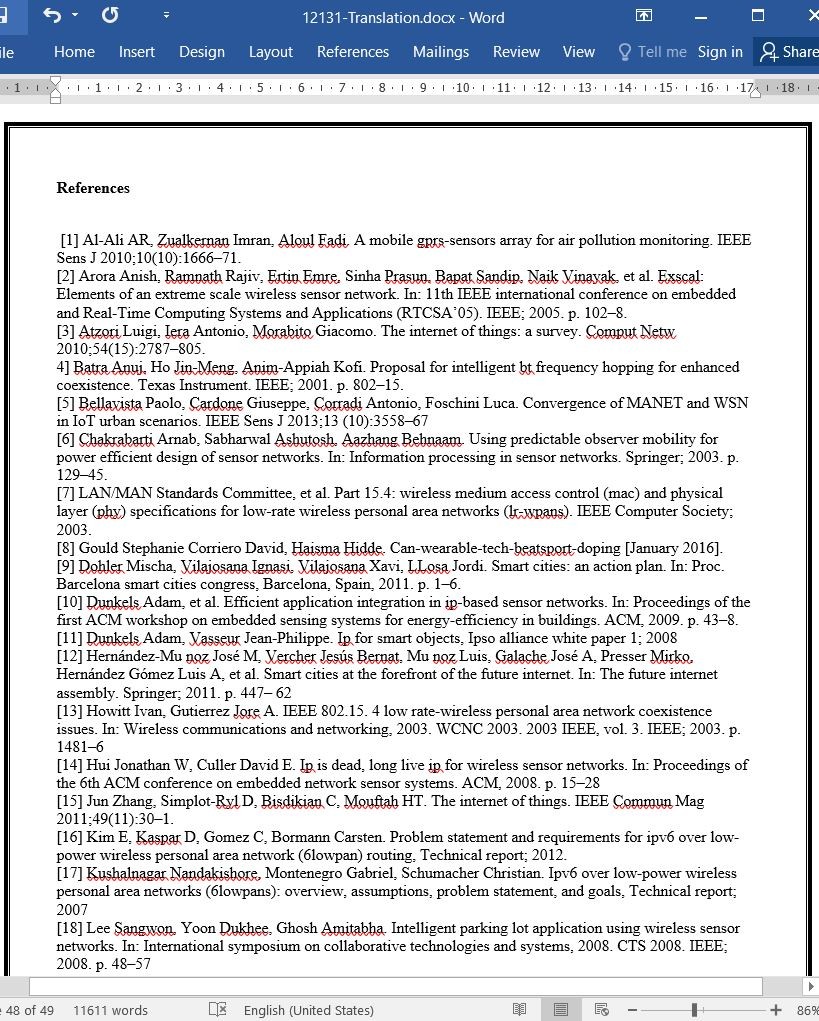
شبکه سازی برای IoT و برنامه ها با استفاده از تکنولوژی های ارتباطی موجود
چکیده
با همگرا شدنMANET به همراه WSN به کار رفته در محیط های هوشمند حاضر در همه جا، فرصتهای جدید برای مانتیور کردن مناطق شهری بزرگ و ایجاد پلتفرمهای ارتباطی جدید برای برنامه های مختلف در دامنه IoT فراهم کرده است. حسگرها در برنامه های IoT استفاده می شوند که محیط را حس می کنند و داده هایشان را برای نود دروازه که داده های جمع شده را برای نود MANET ارسال می کند، می فرستند. چنین کاری به طور خاص برای استنتاج از داده انجام می شود. در اینجا دو برنامه IoT در نظر گرفته شده است که توسط نودهای حسگرهای بی سیم مانیتور می شوند. بخش چالشی این کار ساختن پلتفرمی با قابلیت تبدیل شبکه حسگر به شبکه MANET است چون نودها دارای سطوح توان مختلف و پروتکل های ناهمگن هستند و شرایط استفاده از رابطهای کانال مشترک دارند. ما روش کامل را ارائه کرده ایم که شامل پروتکل های شبکه، توزیع های طیفی، به کار گیری نود، مسیریابی MANET و الگوی تحرک و در نهایت پیاده سازی برنامه های IoT است. برنامه ها با شبیه ساز Omnet++ شبیه سازی شده اند و کارایی و سادگی به کارگیری آنها نشان داده شده است.
1- معرفی
یک الگوری ارتباط جدید که مشهور به IoT است و در آن انواع مختلف اشیائ زندگی روزمره ما از گوشی های هوشمند گرفته تا حسگرها و دستگاههای دارای قابلیت شبکه شدن (مانند FRID) می توانند با هم ارتباط برقرار کنند و بخشی از اینترنت باشند. هدف اصلی IoT الهام بخش و فراگیر کردن بیشتر و بیشتر اینترنت است. با اتصال گستره وسیعی از دستگاههای ناهمگن و ایجاد دسترسی ساده به دستگاهها برنامه های زیادی در IoT استفاده شده اند که با حجم داده تولید شده توسط دستگاههای متصل شده سر و کار دارند و تصمیماتی می گیرند که برای صنعت یا کنترل دستگاههای متصل بر اساس داده های جمع آوری شده بسیارحیاتی است. کاربردهای بزرگی از IoT در حوزه های مختلف مانند اهداف درمانی، اتوماسیون خانه، اتوماسیون صنعتی، مراقبت سلامت همراه، تبدیل و انتقال برق و ... وجود دارد. امروزه شهرهای هوشمند یکی از حوزه های رو به رشد IoT هستند که محققات چندین مدل و استاندارد ارتباطی برای آن پیشنهاد کردهاند و برنامههایی ایجاد کرده اند که با بهبود استاندارد زندگی روزانه شهروندان مقیم این شهرها، زندگی را برای آنها ساده تر می کنند.
6 – نتیجه گیری
ما در این مقاله یک معماری جدید شبکه IoT ارائه کرده ایم که نودهای حسگر و MANET با همدیگر برای ارتباط کارآمد با دروازه های اینترنت ترکیب شده اند. ما دو برنامه مختلف از شبکه IoT را با پروتکل های مختلف لایه MAC در نودهای حسگر در نظر گرفته ایم. برای همزیستی تکنولوژی های مختلف که توسط انواع مختلف نودها استفاده می شوند، برخی برنامه های تخصیص فرکانس در میان این نودها ارائه کرده ایم. در نهایت نیز با شبیه سازی کارایی شبکه و سادگی پیاده سازیمان را برا شبیه سازی مدل پیشنهادیمان برای دو برنامه مختلف نشان دادیم. امنیت یکی از مهمترین مباحث در IoT است که جز در UUID در مدل پیشنهادی به آن توجه نشده است. بنابراین کار بعدی مباحث امنیتی را نیز به کار ما اضافه خواهد کرد.
Abstract
Converging of MANET with WSN used in ubiquitous smart environments opens new prospect in monitoring the large scale urban area and makes a new communication platform for different applications in Internet of Things (IoT) domain. Sensors used for IoT applications, sense the environment and send the data to the gateway node, which in turn send the collected data to the MANET node, especially used for data harvesting. Here we considered two IoT applications which are monitored by wireless sensor nodes. The challenging part of this work is to make a platform by converging sensor network with the MANET network because nodes have different power levels, heterogeneous protocols and have chances of co-channel interferences. We proposed a total solution which includes network protocols, spectrum distribution, node deployment, MANET routing and mobility pattern and finally implementation of the IoT applications which are simulated using Omnet++ simulator and shown their performances and feasibility.
1. Introduction
A recent paradigm of communication which popularly known as Internet of Things (IoT), where all the objects of different kinds of our daily life spanning from smart phones, sensors or devices are associated with network enabled objects (like RFID) can communicate with each other and makes a part of Internet. The main aim of IoT is to make Internet more and more inspiring and pervasive. By connecting wide variety of heterogeneous devices and making easy access of the devices, several applications are being used in IoT, which deals with the large number of data generated by the attached devices and make some decisions which is very important for the industry or control the attached devices based on the generated data. There is a huge use of IoT in several domains like medical aids, home automation, industrial automation, mobile health care, electricity transmission and distribution etc. Now a day smart cities are one of the emerging domain of IoT, where researchers are proposing several communication models and standards and provide some applications which facilitate the residing citizens by enhancing their everyday standard of life.
6. Conclusion
In this paper we have proposed a new architecture of IoT networks, where sensor networks and MANET are combined together for efficient communication with the Internet Gateways. We have considered two different applications of IoT network with different MAC layer protocols at the sensor nodes. For coexistence of different technology used by different type of nodes, we have proposed some frequency allocation scheme among these nodes. And finally we have shown the performance of the network and feasibility of our implementation by simulating our proposed IoT network models for different applications. Security is one of the important issues in IoT, which is not taken care in the proposed model except UUID in soccer model. Thus future work will be incorporating security issues in our present work.
چکیده
1-معرفی
2 – کارهای مرتبط
3 – معمای IoT ارائه شده
1.3 معماری شبکه
2.3 پروتکل پیشنهادی برای معماری سلسله مراتبی
3.3 عملکرد دروازه
4.3 مزایای معماری چند سطحی
4. برنامه های IoT
1.4 سیستم اطلاعاIoT بیمارستان (HIS)
2.4 مانیتور کردن بازیکنان فوتبال از طریق دستگاههای پوشیدنی
3.4 مسیریابی داده و متحرک بودن نودهای MANET
5.شبیه سازی و نتایج
6 – نتیجه گیری
منابع
Abstract
1. Introduction
2. Related work
3. Proposed IoT architecture
3.1. Network architecture
3.2. Proposed protocols for hierarchical architecture
3.3. Function of gateway
3.4. Advantages of multilevel architecture
4. IoT applications
4.1. Hospital information System (HIS)
4.2. Monitoring the soccer players through wearable device
4.3. Routing of data and mobility of MANET nodes
5. Simulation and result
6. Conclusion
References
- اصل مقاله انگلیسی با فرمت ورد (word) با قابلیت ویرایش
- ترجمه فارسی مقاله با فرمت ورد (word) با قابلیت ویرایش، بدون آرم سایت ای ترجمه
- ترجمه فارسی مقاله با فرمت pdf، بدون آرم سایت ای ترجمه



